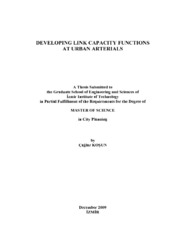Please use this identifier to cite or link to this item:
https://hdl.handle.net/11147/3083Full metadata record
| DC Field | Value | Language |
|---|---|---|
| dc.contributor.advisor | Çelik, Hüseyin Murat | - |
| dc.contributor.author | Koşun, Çağlar | - |
| dc.date.accessioned | 2014-07-22T13:50:50Z | - |
| dc.date.available | 2014-07-22T13:50:50Z | - |
| dc.date.issued | 2009 | - |
| dc.identifier.uri | http://hdl.handle.net/11147/3083 | - |
| dc.description | Thesis (Master)--Izmir Institute of Technology, City and Regional Planning, Izmir, 2009 | en_US |
| dc.description | Includes bibliographical references (leaves: 67) | en_US |
| dc.description | Text in English; Abstract: Turkish and English | en_US |
| dc.description | xi, 77 leaves | en_US |
| dc.description.abstract | Link capacity functions are the relationships among the main variables of the vehicular traffic flow at any links. Moreover, developing link capacity function is a task that is related to traffic engineering, yet it is too difficult to find a unique link capacity function belonging to all links in cities. Therefore, this thesis does aim to develop link capacity functions peculiar to the selected divided and undivided links in downtown city İzmir. The main process of developing the link capacity functions depends upon the fastidious site selection, data collection and data analyses techniques. Especially, the main vehicular traffic variables such as flow rate, capacity, speed, travel time data describe the links capacity function. After the data collection process, the data manipulation and their analyses lead to build mathematical model about the link capacity functions. When considering the steps of this thesis, first of all, this thesis reviews the literature and formulates the problem statement and the research objective. Secondly, it conducts the task that consists of the site selection and data collection. In the following parts, this thesis study manipulates and analyzes the obtained data. Then, it performs the linear and non-linear model building by utilizing different functions called V/C ratio & dummy variable, BPR (Bureau of Public Roads) function and Overgaard function for the selected link groups in İzmir. Ultimately, this thesis study compares the model results and manifests the best link capacity function model. | en_US |
| dc.language.iso | en | en_US |
| dc.publisher | Izmir Institute of Technology | en_US |
| dc.rights | info:eu-repo/semantics/openAccess | en_US |
| dc.subject.lcc | HE333 .K86 2009 | en |
| dc.subject.lcsh | Traffic engineering | en |
| dc.subject.lcsh | City traffic--Turkey | en |
| dc.title | Developing Link Capacity Functions at Urban Arterials | en_US |
| dc.type | Master Thesis | en_US |
| dc.institutionauthor | Koşun, Çağlar | - |
| dc.department | Thesis (Master)--İzmir Institute of Technology, City and Regional Planning | en_US |
| dc.relation.publicationcategory | Tez | en_US |
| dc.identifier.wosquality | N/A | - |
| dc.identifier.scopusquality | N/A | - |
| item.openairecristype | http://purl.org/coar/resource_type/c_18cf | - |
| item.languageiso639-1 | en | - |
| item.openairetype | Master Thesis | - |
| item.grantfulltext | open | - |
| item.fulltext | With Fulltext | - |
| item.cerifentitytype | Publications | - |
| Appears in Collections: | Master Degree / Yüksek Lisans Tezleri | |
Files in This Item:
| File | Description | Size | Format | |
|---|---|---|---|---|
| T000172.pdf | MasterThesis | 819.38 kB | Adobe PDF |  View/Open |
CORE Recommender
Page view(s)
42,184
checked on Mar 31, 2025
Download(s)
72
checked on Mar 31, 2025
Google ScholarTM
Check
Items in GCRIS Repository are protected by copyright, with all rights reserved, unless otherwise indicated.